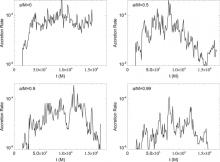
Abstract
We present the results of a new series of global, three-dimensional, relativistic magnetohydrodynamic (MHD) simulations of thin accretion disks around spinning black holes. The disks have aspect ratios of  and spin parameters of
and spin parameters of  , and 0.99. Using the ray-tracing code Pandurata, we generate broadband thermal spectra and polarization signatures from the MHD simulations. We find that the simulated spectra can be well fit with a simple, universal emissivity profile that better reproduces the behavior of the emission from the inner disk, compared to traditional analyses carried out using a Novikov–Thorne thin disk model. Finally, we show how spectropolarization observations can be used to convincingly break the spin-inclination degeneracy well known to the continuum-fitting method of measuring black hole spin.
, and 0.99. Using the ray-tracing code Pandurata, we generate broadband thermal spectra and polarization signatures from the MHD simulations. We find that the simulated spectra can be well fit with a simple, universal emissivity profile that better reproduces the behavior of the emission from the inner disk, compared to traditional analyses carried out using a Novikov–Thorne thin disk model. Finally, we show how spectropolarization observations can be used to convincingly break the spin-inclination degeneracy well known to the continuum-fitting method of measuring black hole spin.